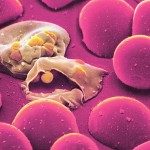Link to Pubmed [PMID] – 28522323
Methods 2017 Aug;127:37-44
Hematogenous dissemination followed by tissue tropism is a characteristic of the infectious process of many pathogens including those transmitted by blood-feeding vectors. After entering into the blood circulation, these pathogens must arrest in the target organ before they infect a specific tissue. Here, we describe a non-invasive method to visualize and quantify the homing of pathogens to the host tissues. By using in vivo bioluminescence imaging we quantify the accumulation of luciferase-expressing parasites in the host organs during the first minutes following their intravascular inoculation in mice. Using this technique we show that in the malarial infection, once in the blood circulation, most of bioluminescent Plasmodium berghei sporozoites, the parasite stage transmitted to the host skin by a mosquito bite, rapidly home to the liver where they invade and develop inside hepatocytes. This homing is specific to this developmental stage since blood stage parasites do not accumulate in the liver, as well as extracellular Trypanosoma brucei bloodstream forms and liver-infecting Leishmania infantum amastigotes. Finally, this method can be used to study the dynamics of tissue tropism of parasites, dissect the molecular and cellular basis of their increased arrest in organs and to evaluate immune interventions designed to block this targeted interaction.

